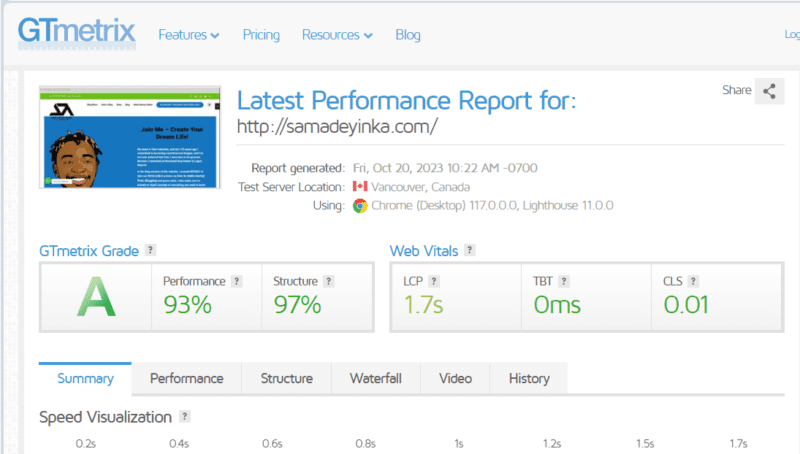Server Response Time is the heartbeat of your website’s speed and performance. It’s the time it takes for your web server to respond to a user’s request when they click on a link or type in your URL. Think of it as the digital concierge at the entrance of your website, responsible for greeting your visitors and guiding them through your content.
You might ask, “Sam, why is Server Response Time so critical?”
Well, good question.
A slow server response can lead to a multitude of issues. It affects not only user satisfaction but also plays a pivotal role in search engine rankings. As search engines like Google emphasize user experience, they consider server response time as a key factor in determining how well your site performs in search results.
Let me give you a typical example: so, you’re at a crowded airport, and there are two lines at security—one moving lightning fast and the other at a snail’s pace. Which one are you more likely to choose?
Well, don’t tell me… I already know your answer. 😊
Now guess what, your website visitors face the same dilemma I shared above. This is why you need to do everything within your power to make sure you learn how to reduce server response time in WordPress or get a WordPress speed optimization service from any trusted WordPress SEO Consultant or Developer.
That said, let me reiterate by saying a slow server response time can lead to a high bounce rate, which impacts your website’s user experience and SEO ranking. But it goes even deeper than that. Search engines, like Google, also consider server response time when ranking websites. They want to ensure that they’re directing users to websites that can provide a seamless experience. If your server response time is sluggish, your SEO ranking can suffer.
Now, you might wonder, “Why should I care about server response time?” To put it bluntly, your site’s speed is a make-or-break factor. Based on a considerable amount of research, I’ve found that for every additional 100 milliseconds of load time, online businesses may experience a 20% drop in traffic. That’s a significant loss for every fraction of a second your visitors are left waiting. Furthermore, slow-loading sites often rank lower on search engine results pages (SERPs), affecting organic traffic and discoverability.
In this comprehensive guide, we’ll delve deep into everything you need to know about server response time in WordPress. You’ll gain a clear understanding of what it entails, its significance and impact on your website, and why it should be a focal point in your optimization efforts. Moreover, I’ll try my best to equip you with actionable strategies and advanced techniques to drastically reduce server response time, ensuring your WordPress site runs at peak performance.
Whether you're a seasoned WordPress pro or just starting your online journey, optimizing server response time is essential for delivering a seamless, enjoyable experience to your visitors. Share on XTable of Contents
ToggleWhat is Server Response Time?
Server response time, often referred to as Time to First Byte (TTFB), is the duration it takes for a web server to respond to a user’s request. This includes the time it takes for the server to receive the request, process it, and send the initial data back to the user’s browser. In simpler terms, it’s the waiting period users experience before any part of your web page begins to load.
Why You Need to Reduce Server Response Time in WordPress
Why does reducing server response time matter specifically for WordPress users? As one of the most popular Content Management Systems (CMS) worldwide, WordPress powers millions of websites. However, its flexibility and feature-rich environment can lead to extended server response times if not optimized correctly. In this guide, we’ll dive deep into WordPress-specific solutions to make your site lightning-fast. Whether you’re a seasoned WordPress pro or just starting your online journey, optimizing server response time is essential for delivering a seamless, enjoyable experience to your visitors.
This article will take you on a journey through the intricacies of server response time, exploring its role in site speed, SEO, and user engagement. Along the way, we’ll discuss practical strategies, optimizations, and recommended tools to help you achieve rapid server response times, enhancing your website’s overall performance, which inevitably improves your WordPress page loading speed.

How I reduced my server response time and increased PageSpeed score
Must Read: Unlocking $6000: A Blueprint for Successful Blogging Earnings in Nigeria
What is Initial Server Response Time in WordPress?
Speaking about initial server response time, it’s that pivotal moment when your server receives a request and quickly sends back the first bytes of data to be displayed. In essence, it’s your website’s first handshake with the user, setting the stage for the entire browsing experience.
A speedy initial server response time is a clear signal to visitors that your website means business. It indicates that your server is primed, responsive, and capable of delivering content swiftly. This not only enhances user satisfaction but also aligns with search engines’ preferences for fast-loading websites.
Long web server response times delay page loading speeds. Page Speed expects your server to begin responding to resource requests quickly to ensure a quick page load time. For each resource request, your server needs to begin… Share on XServer Response Time vs. Page Speed
Understanding server response time in WordPress goes hand in hand with comprehending page speed. These two aspects are like twins separated at birth—they’re closely related, but not quite the same.
Server response time is the starting point of your page’s journey to load completely. It’s like the sprinter at the starting blocks, ready to burst into action. Once the server response time is swift, the rest of the race—loading images, scripts, and content—becomes more efficient.
In contrast, page speed is the full marathon. It encompasses every element of your website’s performance. Faster server response time is the catalyst for an outstanding page speed score. Together, they ensure a smooth, seamless, and engaging user experience.
Common Factors Affecting Server Response Time
You see, when it comes to server response time, there are various critical factors in play. Understanding what influences server response time is the first step in your journey to optimize it for your WordPress website. Here, we’ll explore these key factors and highlight the specific challenges that WordPress websites may face in this context.
Let’s Analyze the Factors That Influence Server Response Time…
To improve your server response time in WordPress, it’s essential to have a grasp of the elements that shape this metric. Addressing these factors effectively can significantly enhance your page loading speed.
Server Configuration: The way your server is set up can either boost or hinder server response time. Elements such as server location, hardware, and software configurations all play a pivotal role.
Web Hosting: I beg to submit to you that the choice of web hosting service is absolutely crucial—it will either make or mar your blog. I should also tell you that shared hosting, while cost-effective, might lead to slower response times due to resource sharing. Opting for premium or managed WordPress hosting often results in better response times. However, for this blog, I currently make use of Interserver’s web hosting service and I haven’t really had any issues with server response time… in fact, my website scores high on PageSpeed, thanks to the GTmetrix image below.

GTmetrix Page Speed Score
Let me also be honest with you… you might find it difficult to improve your page speed score just like I did above if you don’t know how to 1) partner with your web hosting company, 2) use and merge the best WordPress caching plugins, 3) use Cloudflare to complement and optimize your website speed and performance, and lastly, how to use .htaccess to effectively jump up your website’s performance.
That said, shared hosting is not exactly the best, especially if you’d love your website to be blazing-fast. However, you can improve your server response time, even if you are on a shared web hosting just like my site (this website).
By the way, you can watch the video below to understand PageSpeed Insight, why and how to improve your website and get a high page speed score.
[]
Server Load: Overloading your server with too many requests or resource-intensive tasks can be a major cause of slow response times. Efficiently managing server load is key to maintaining optimal performance.
Content Delivery Network (CDN): CDNs act as accelerators for your website. By distributing your site’s content across multiple servers globally, they can effectively reduce the physical distance between your server and your site visitors, resulting in quicker response times.
Caching Mechanisms: Caching plugins and server-side caching can help minimize server response time. These mechanisms store and serve pre-generated pages, reducing the need to process dynamic content for each visitor. Plugins like W3 Total Cache, WP Super Cache, or WP Rocket (I use this on each of my blogs) are highly recommended.
Specific Challenges in WordPress Server Response Time…
While WordPress is a versatile platform for websites and blogs (see why I love and use WordPress), it comes with particular challenges when it comes to server response time optimization:
Complexity: WordPress sites often incorporate a variety of themes and plugins, adding functionality but potentially increasing server load and response times. Opting for lightweight, well-coded themes and plugins is a wise choice. And… if I were you, I wouldn’t go crazy on installing too many plugins, which might wound up causing slow response times.
Database Queries: WordPress’s dynamic content is a crucial feature, but extensive database queries can slow down server response times. Optimizing your database and using plugins that minimize queries can alleviate this issue.
Media Content: Visual elements like images and multimedia are essential for an appealing website. However, large media files can strain server resources. Properly sizing and compressing images can significantly improve your site’s response time. I will shed more light on this later.
Comprehending these factors and recognizing the unique challenges in WordPress server response time provides a solid foundation for implementing effective strategies and optimizations. Your journey to a faster, more responsive WordPress site begins by identifying these hurdles and proactively taking steps to overcome them.
If you’re still reading, don’t worry, you’ll learn all of the actionable techniques and strategies that will help you reduce server response time and boost your website’s speed. I will explore everything from WordPress-specific solutions to high-speed hosting, content delivery networks, image and resource optimization, and advanced server-side optimizations. Just make sure to keep reading (or bookmark this page for a later read). 😊
The faster your website's load time is, the happier your visitors will be. In other words — when you optimize your web page's load time, you can expect to see improvements in user experience (UX), conversion rates, and ultimately,… Share on XThe Consequences of Slow Server Response Time
Slow server response time is more than just an inconvenience. It can have far-reaching impacts on your website’s performance and success. Let’s delve into real-world examples and statistics to understand why reducing server response time is crucial for improving user experience, SEO rankings, and conversion rates.
According to HubSpot, “The faster your website’s load time is, the happier your visitors will be. In other words — when you optimize your web page’s load time, you can expect to see improvements in user experience (UX), conversion rates, and ultimately, sales revenue.”
Real-World Examples and Statistics
I’ve got a few great statistics to share with you below, in case you’re wondering, “But Sam, how about you share a few real-life examples or statistics about the importance of reducing server response time and increasing page speed?”
That’s okay, I’m going to clear your doubts just now, but listen to this: back in 2019, the guys at Backlinko researched and analyzed 5 million desktop and mobile pages to learn which factors impact page speed, and here’s what they found out:
- The average desktop Time to First Byte (TTFB) speed is 1.286 seconds on desktop and 2.594 seconds on mobile. The average time it takes to fully load a webpage is 10.3 seconds on desktop and 27.3 seconds on mobile.
- The average web page takes 87.84% longer to load on mobile vs. desktop.
- Total page weight is the #1 determinant of Fully Loaded page speed. Light pages fully load 486% faster than large pages.
Below are three more statistics to blow your mind away…
- The first five seconds of page-load time have the highest impact on conversion rates. (Portent, 2019)
- Website conversion rates drop by an average of 4.42% with each additional second of load time (between seconds 0-5). (Portent, 2019)
- The average mobile web page takes 15.3 seconds to load. (Google Research, 2018)
The statistics above highlight the direct correlation between server response time and the bottom line. Like I said before, slow-loading websites not only frustrate users but also impact your potential to generate revenue.
That said, a few extra seconds can mean the difference between a satisfied visitor and a lost opportunity. Don’t you just agree with me? 😜
Impact on User Experience, SEO, and Conversions
- User Experience: Your website’s load time significantly influences the user experience. When visitors encounter sluggish response times, they’re more likely to bounce off your site in search of a faster alternative. This not only increases your bounce rate but also tarnishes your brand’s reputation.
- SEO Rankings: Search engines, particularly Google, value user experience. As part of their ranking algorithms, they consider factors such as page load speed. If your website’s server response time is consistently slow, it can negatively affect your search engine rankings. Your slow-loading site might be outranked by competitors with faster load times.
- Conversions: Whether you’re running an e-commerce site or a content-based blog, conversions are the lifeblood of your online presence. Slow server response times make it harder for users to complete desired actions like making a purchase or subscribing to your newsletter. By optimizing server response time, you enhance the likelihood of visitors becoming loyal customers.
Pro Tip: Understanding the consequences and recognizing the urgency of improving your server’s response time, you’re better equipped to take action and enhance your website’s overall performance.
Read This: How to Create an Authority Blog (Step-by-Step Guide)


















Amazing! Congratulations!
I am genuinely thrilled by the depth and value this article, “How Can I Reduce Server Response Time and Increase Pagespeed Score?” provides. It’s a goldmine of insights, offering not just an explanation but a comprehensive guide on reducing server response time in WordPress. The article makes this complex technical concept understandable for all readers, ensuring everyone, from novices to seasoned web developers, can harness these strategies effectively. Moreover, it covers every critical aspect, from server configurations to WordPress-specific challenges, and the impact of server response time on user experience and SEO rankings. It’s a must-read for anyone looking to optimize their website’s performance and offer a seamless, lightning-fast experience to their visitors.